

Oriana Leckert is the founder of the website Brooklyn Spaces and has also been an Untapped Cities contributor, writing one of our favorite pieces on 7 of the most unique bathrooms in the city. The tenacity of her expedition around the city to find these bizarre toilets has only been amplified for her book Brooklyn Spaces, a compendium of 50 Brooklyn hubs of culture and creativity. These are community-grown, artist-founded spaces within the post-manufacturing/post-industrial landscape, in buildings and lots that have been hacked, adapted and reused. You can tell Leckert knows Brooklyn (at least this part of Brooklyn, she admits) inside and out, and each location is told with a knowledgable ease that comes with already being a part of the place and a sense of humor.
In many ways, Brooklyn Spaces is a love letter to a type of creative culture that has been thriving in Brooklyn, but is not necessarily distinct to it. Jeff Stark of Nonsense NYC who has been behind some of the best underground events we’ve attended, wrote the forward with the bold statement: “Our city is just like your city.” In one swoop, he elevated this book beyond a hyperlocal guide–it’s a testament to those always pushing the boundaries, in Brooklyn, or elsewhere. This book is not about lamenting a lost New York City, it’s about celebrating and recognizing that the city is very much still alive–if you know where to look for it. And it’s about how these types of hubs survive.
But it’s also a warning–some locations mentioned in the book–the Gowanus Batcave, Death by Audio–have closed or underwent evolutions since the manuscript was submitted. It also speaks to the tremendous evolution that Williamsburg and its environs have gone through–in 1998, Leckert’s introduction to Brooklyn began on a deserted Bedford Avenue. As Leckert writes,”the aim of this book is not to document a century’s worth of creative culture, but to trace a specific artist renaissance that has manifested over the last twenty years.”
As Leckert addresses, as important as the artists themselves are the urban planning moves that have enabled the reclamation of industrial Brooklyn, which she traces to the work of Two Trees, and David and Jed Walentas in Dumbo.
There is a wide range of locations offered in the book–from Superhero Supply Store that serves as a front to a writing lab for students, a trapeze school in a former ice warehouse, a boat club on the Gowanus to a lab for amateur biologists. Each stylized page shows the space, neighborhood, original purpose of the building and current use. One thing you’ll notice about the book is how alive these spaces look in photographs, from the cover image to the interior shots.
We asked Oriana to highlight 5 of the most quintessential Brooklyn Spaces for us. Without further ado, here are the spots with small excerpts from the book:
5. Gowanus Ballroom
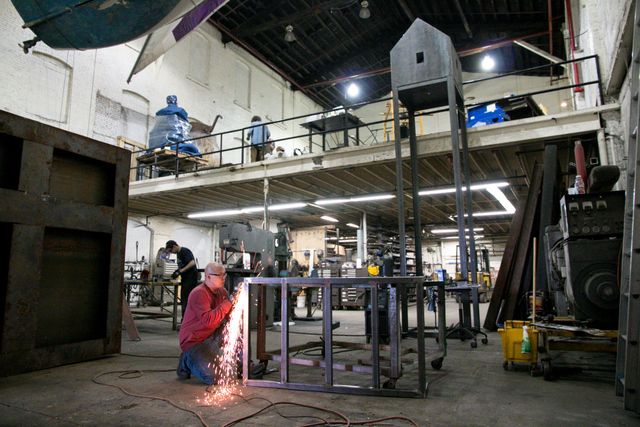
The Gowanus Ballroom/Serett Metalworks. Photo by Alix Piorun
“It’s a fucking beautiful shithole, this insane old place,” says Josh Young, Gowanus Ballroom proprietor. The cavernous 16,000-square-foot building–formerly a steel mill, before that a chemical plant, and before that a cannonball factory–is now home to Serett Metalworks, a crafting, fabrication and design firm. Every few months the space transforms into a venue for massive art and performance spectacles.
Text excerpted from Brooklyn Spaces.
4. Silent Barn
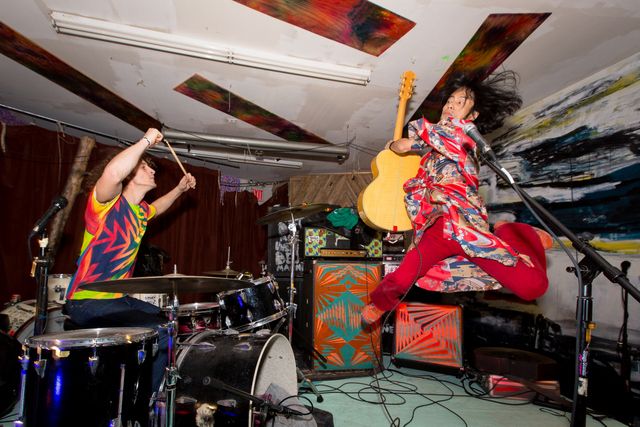
Silent Barn. Photo by Walter Wlodarczyk
Silent Barn was an early entrant into Brooklyn’s wild DIY music scene: it started in Ridgewood, Queens, in 2004, when the band Skeletons began putting on all-ages shows in the kitchen of the repurposed textile factory they lived in. The musical offerings were always inexpensive and extremely varied, from hardcore to hip-hop to chiptune, and the space was popular and well-loved. But in July 2011, the Department of Buildings ordered the residents of the Barn to vacate because they were illegally living in an indusrial space. Mere adys later, the building was ransacked and about $15,000 worth of equipment was destroyed or stolen.
That could have been the end, but instead the collective launched a successful Kickstarter campaign, raising $40,000 toward a new space…It took nearly two years for the collective to find a mixed-use space that was big enough for its growing community but in early 2013, Silent Barn 2.0 opened its doors in Bushwick.
Text excerpted from Brooklyn Spaces.
3. The Chicken Hut
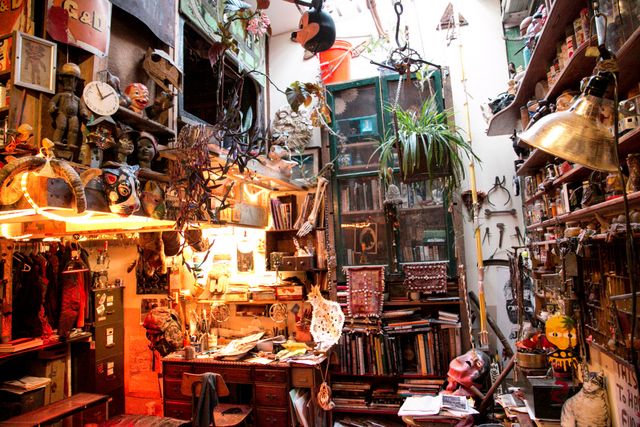
The Chicken Hut. Photo by Alix Piorun
In a Brooklyn that gets more sanitized every day, there are still a few wild holdouts, and the Chicken Hut is one of the last men standing. “This is our reckless abandon studio,” says Greg Henderson, who started the space with fellow woodworker JPL in 2000. “It’s our home and the place where we an do every crazy fucking thing we’ve ever thought of.”…
The Hut has always been home to artists, builders, and renegade makers, from puppeteers to sculptors to luthiers. The space serves as an archive of their creations: robotic aliens, giant rubber sea creatures, and papier-mâché animal heads. It’s also a hub for intense artistic collaboration; in 2013 everyone participaed in a massive group art show in Long Island City called “Headscapes: A Brainstorm of Installations.”
Text excerpted from Brooklyn Spaces.
2. House of Yes
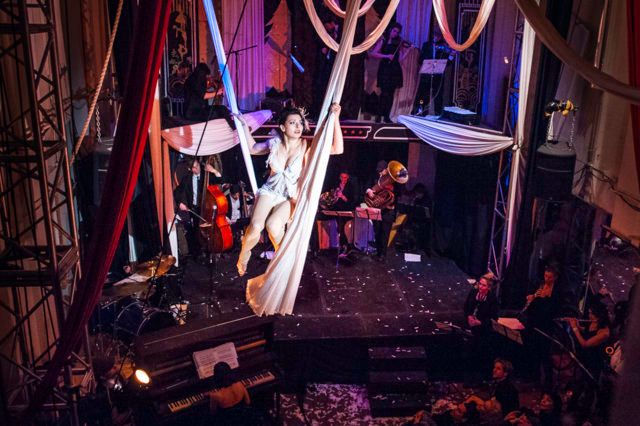
House of Yes. Photo by Michael Blase.
Most underground spaces get only one shot–but the House of Yes–an innovative, ambitious, aerial performance venue–has gotten three, weathering serious odds for each incarnation to be bigger and brighter than the last…
The new House of Yes is a home for aerial dinner theatre, cabaret, dance parties, film screenings, fashion shows, experimental performances, and any other fascinating thing that comes along. “DIY spaes are a reflection of the people who create them,” [co-founder Anya Sapozhnikova] says. “This is us as artists: we build the shell of these spaces around us, and then we grow.”
Text excerpted from Brooklyn Spaces.
1. Secret Project Robot
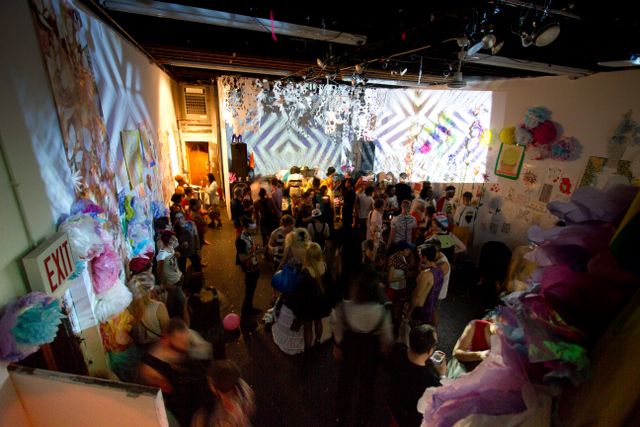
Secret Project Robot. Photo by Maximus Comissar.
Secret Project Robot is part of the old guard of North Brooklyn spaces…In its current incarnation, Secret Project Robot is a non-profit hybrid music and art space featuring a gallery, two stages, and twenty-seven artists spread across eight studios, including three soundproofed repurposed metal freight containers. The studios are inexpensive for the [Bushwick] neighborhood: “We want the cost to reflect the spirit of what we’re about,” says Rachel, “which is supporting artists and creating a healthy environment for people to work and create together.”
Text excerpted from Brooklyn Spaces.
With spread of photographs across multiple pages for each location, Brooklyn Spaces is a must-have for Brooklynites, New Yorkers, those who came of age in the dawn of the borough’s creative renaissance and those who are looking to get a start. Buy it here. For more creative hubs, also follow Leckert’s website Brooklyn Spaces.


